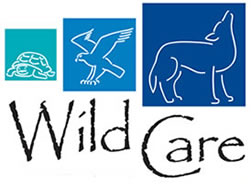“Perhaps not my Best, but…”
Adventures of a Wild Care Volunteer, by Amy Sanders
Several months ago, you read a story about how not to handle a gannet (involving a rather unpleasant car ride with a pterodactyl-like bird loose in my car before I was a volunteer). The moral of the story was to leave gannets to the Wild Care folks to capture and transport. This month? A story about how even trained Wild Care volunteers sometimes have difficulty on gannet calls (I think rehabbers always do great!). And yes, this is about me. I wouldn’t embarrass anyone else the way I would myself.
So, sometime last winter, someone in the vicinity of Old Wharf Road in Wellfleet called in about a sick gannet that was resting at the tide line along the south side of Blackfish Creek. I knew the area so when I was called I was comfortable heading out. I drove to the area, and was immediately delighted that I knew the area very well. It turned out to be a property formerly owned by a friend of mine, so a bit of nostalgia rolled through my mind as I got my gear and headed to the back of the property where the bird was reported to be.
Now remember, this is a large bird! Six-foot wing span, and long sharp beak that I know will go for my face if I’m not fast. But, I’ve been trained this time! I spotted the bird, sure enough, on the tide line, but seemingly fast asleep with his head tucked into his feathers. Yippee! An easy rescue, I thought. I’ll just get this sheet on him before he wakes up and voila! One bird off to Wild Care. Or so I thought, still obviously being day-dreaming about former times on the property.
I had my gloves and goggles, and my bin and duct tape, and my sheet, so I was ready. I stealthily approached the bird. No movement. I crept a bit closer and…no movement. I am home free I think. I raised the sheet and tossed it over the bird, and…the bird exploded in a fury of frantic efforts to free itself! It was like dynamite under that sheet.
Now, the first objective of a trained gannet rescuer is to capture that beak in one hand, less one come home with serious injuries inflicted by it. But here, where was that beak in all that fury? I had no clue. I knew only that I had to act fast, so I did the only thing I could think of. I put my entire body over the bird. I’m not cruel—I held my weight with my legs and one hand white the other searched for the beak in the roiling wave of the sheet. But I am not a spring chicken anymore, so while I was able to find the beak, the force the bird exerted on my hand was no match to my precarious balance and so, enraged bird and embarrassed rescuer rolled in a pile ever so indelicately down the slight slope, into the mud.
While my pride was rather damaged, the bird was uninjured in the foolishness. I gathered up my balance, righted myself, quickly wrapped the bird in the amazingly relatively clean sheet (I was not so relatively clean), tucked him (or her) into the bin, sat on it and shakingly applied duct tape to keep the bird contained and safe in the car, while darting my eyes around a bit to see who might be laughing at me. I half expected to appear on someone’s Facebook post in full high-definition video. But alas, no one appears to have actually witnessed this at all. So no pictures, fortunately no videos—just a silly tale to put in our newsletter, and a lesson. Don’t assume a sleeping bird is going to be a calm or easy rescue!
Wild Night Out Online Auction
READY, SET, BID… We are so excited to announce that our Wild Night Out Online Auction is now live!
READ ALL NEWS
CALENDAR OF EVENTS
04 April, 2024
Wild Night Out Online Auction
EVENT DETAILS
05 April, 2024
Wild Night Out
EVENT DETAILS
28 February, 2024
Wildlife Winter/Spring Talk Series
EVENT DETAILS

DID YOU KNOW??
Wild Care has a state-of-the-art seabird therapy pool, which allows seabirds and waterfowl to exercise on running water. This will help our bird friends recover more quickly so they can get back to their watery habitats!

